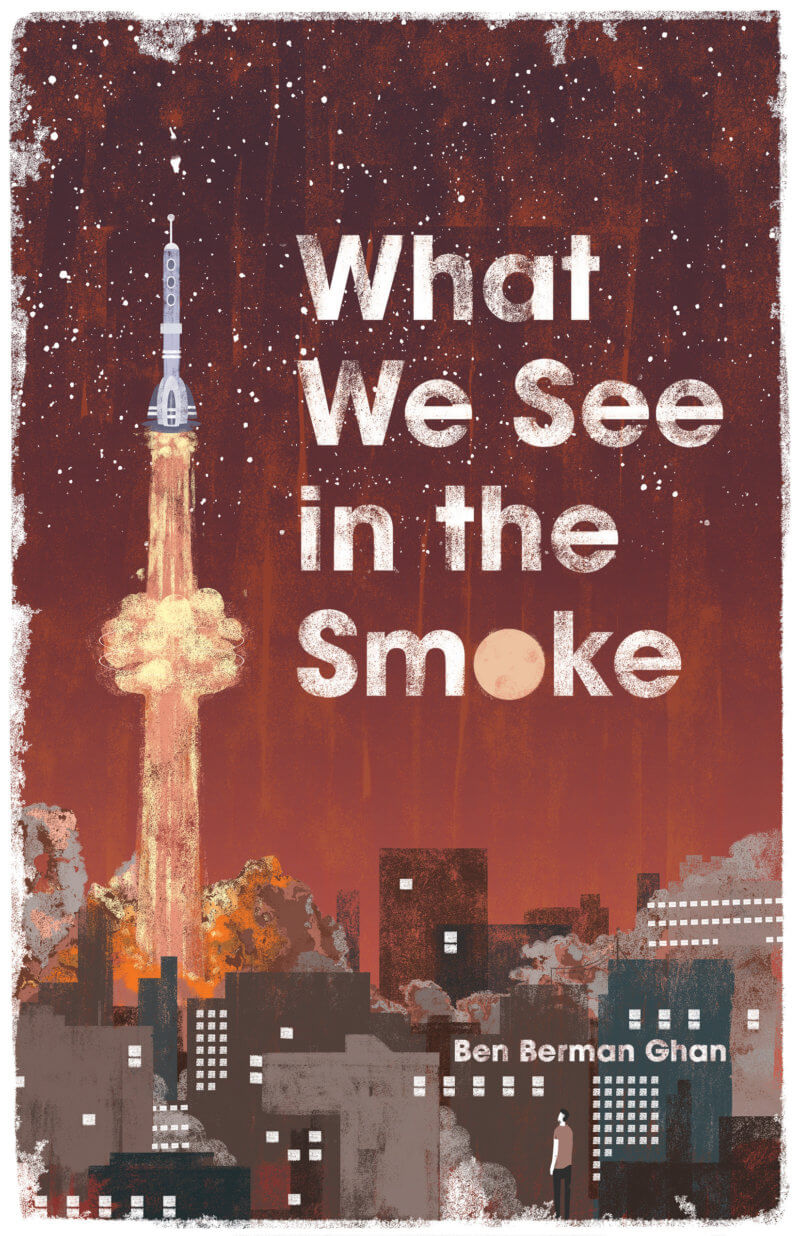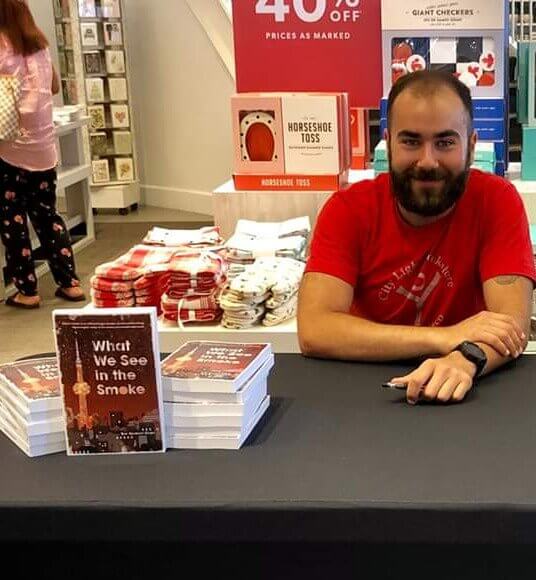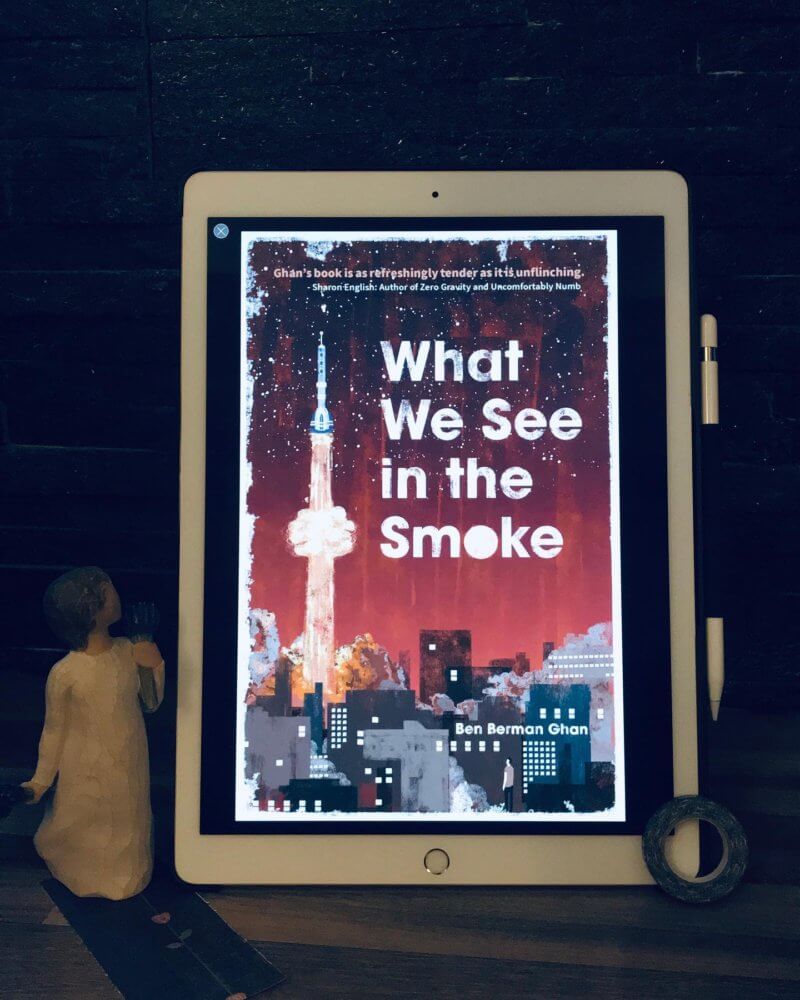
What we see in the Smoke is a collection of short stories by Ben Berman Ghan. Set in 2016-3036, most are based in Toronto, Canada, while some follow people who originated from there. I had the opportunity to read its advanced copy before publication through NetGalley and I have not stopped raving about it since. If you haven’t read my review of it already, take a look here. You will find the synopsis of the book there too.
I am always curious to know what goes on in writer’s minds. Thus, when Ben agreed to an interview about his book, I was over the moon! I chatted with Ben about the ideas behind his book and I am excited to share our conversation. We talked about his book and I also got to know more about his writing routine.
My curiosity about What we see in the smoke
- Did What we see in the smoke start out as one story or was it always supposed to be multiple stories on a timeline? Did you end up writing it the way you had envisioned the very first idea?
Yes, the book was always envisioned along a timeline the way it was, although one of the joys about writing in this fashion was that the timeline was allowed to slip and shift as I thought of new stories and new ideas to fit into it. It didn’t end up exactly the way I envisioned it, as at one point the book was much shorter, and the original ending actually landed in the middle of the book! I ended up shifting the timeline from 2002-2250 to 2016-3036. That was a big change! Also, the actual stories themselves often ended up far different from what I envisioned in initial drafts. Often, I found their meanings in the edit. - What we see in the smoke touches on many of the insecurities that we have about the future with the advent of technology and automation. Why did you choose to address these themes?
See that’s an interesting question, I actually am far less of a luddite than you might think. It’s not really advances in technology and automation that I felt I was portraying as a problem, but the commodification of human beings that might come with advancement. At one point, I suggest that automation and androids have taken over the entire workforce. But is the problem that they’ve stolen all the jobs of the middle class, or that capitalism is doomed to failure in a world where we continue to advance? I live in Ontario, and I watched an attempt at universal income get scratched (again) while writing this book, and these things stuck in my mind. - You used a number of different narratives in the book, telling the history of this world from a unique point of view, whether they were humans or androids. I really enjoyed that! How did you choose between which voice to use for a story?
I don’t choose the voices I used for a story. Each thing I write always seems like the only thing I can write in that moment. So it sort of feels like I didn’t choose. I wrote whatever I needed to write. - Are there certain characters you would like to go back to and explore their story further?
There are lots of ideas I’d like to come back to, but not characters. I think I’m done with all the characters in this book, as I’ve spent a lot of time with them as it is. That being said I may return to some in the future if the inspiration strikes. - Your love for Toronto is deeply rooted in this book. If you could have chosen another place as the stage for this novel, which city would that have been?
If I’d picked a different location, it would have been a different book. So to write this book, it couldn’t have been in a different place. - Why did you choose What we see in the smoke as the title?
You know for a long time, that was not the title! I had a lot of trouble picking the title of this book, but none of them quite fit. Even the title story wasn’t called that originally. The title What We See in the Smoke only appeared in the final draft of that story, and I had to mull it over with several people I greatly respect. In the end, I felt it was the best one, both because it’s a snappy title, and because I felt it suggested more of the themes of the book than other titles I’d considered. In the end I think it was Sharon English (author of Zero Gravity and Uncomfortably Numb) who helped me decide. - What are some takeaways from What we see in the smoke that you would improve upon for your next book? Have you started writing it already? 🙂
All writing this book taught me how to do was to write this book. I now have to learn how to write the next one. But yes, I’ve started.

My curiosity about Ben’s writing routine
- What does your writing routine look like?
I try to wake up, have coffee, and write a little in the morning. On a good day for me, I go and sit somewhere, write for maybe 40 minutes, get up and walk around, and write for another 40, until eventually I burn out. I tend to write notes by hand, but stories on the computer. - How do you select the names of your characters? Are they just names that appeal to you or did you look them up for a special meaning?
I often don’t select names for my characters until the end of the first drafts. I hate naming characters. I have no idea why. - Are there any books that you would say influenced and shaped you as a writer?
Yes, so many. Too many to mention. But I’m happy to namedrop authors like Neil Gaiman, Ray Bradbury, Ted Chiang, Larisa Lai, Kurt Vonnegut, Philip K Dick, N. K. Jemisin, A.S. Byatt… I think the list would go on forever, so I’ll try to stop. I’m also sure I’ve just forgotten some important inspirations and I’ll remember at 2am. - What would you tell your younger self when it comes to writing?
Shut up kid. Do the work.

What we see in the smoke is now available in stores! My thoughts on it can be found here. 🙂

Be First to Comment